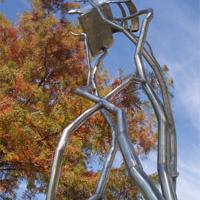For me, art is a way of telling my life story. Just writing this article is a momentous struggle, each word a battle in a never-ending war. I am profoundly dyslexic and have never become a fluent reader, and I struggle with the mechanics of writing every day. Ironically, I have a lot to say. It just takes me a little time to find my voice.
Growing up, school was both a difficult and rewarding place for me. At times, the challenge of reading seemed insurmountable, and this would eventually inspire pieces like “Higher Education II”.
The fourth grade was a particularly difficult year for me. I had just started at a new school that for the first time had high expectations, and I had to come to terms with the fact that I had to work harder than others to complete my class work; “Collision of a Fourth Grader” is a expression of my feelings at the time. However with the appropriate accommodations, such as audio books provided by Recording for the Blind & Dyslexic and someone to dictate my papers, I was able to be very successful. I learned to express myself in spite of the written word, and today, I even have a Masters in Fine Art. But the best life lesson I learned actually didn’t come from books — it came from a broken arm.
I was in the 5th grade, and I was enrolled in a summer school art class. I broke my arm that summer, and at the time, I felt I would have to withdraw from the class because of the injury. When I went into the classroom for my first day I let the teacher know I could not participate. “What do you think people who can’t use their arms do if they want to be artists?” she asked. “They don’t let their disability stand in their way. They hold a paint brush with their mouth or in their toes to draw. Just because your right hand isn’t working doesn’t mean you can’t be an artist.”
The rest of that summer I did just that: painting with my mouth and feet. I learned that if having a broken arm wasn’t going to stop me in art class, my dyslexia wasn’t going to stop me in Life.
Like the broken arm, dyslexia has given me many challenges to deal with on a daily basis, and still does to this day. In 2003, on the advice of a professor and mentor in graduate school, I started using art to talk about my life as a dyslexic person. One of my first pieces on that theme, “Repetition of Unreadable Books,” is a collection of 98 books in concrete blocks: It’s meant to illustrate my experience in a world where text is often inaccessible. At the same time I see the book as an integral part of my like the body of text feels like an extension of my own body and the words are spilling out. It’s funny though: if someone were to ask me if I would trade my dyslexia, I would say no. Why? Because like the broken arm, I would not have gained the lessons that this adversity has given me.
About the Author
Eric McGehearty has shown his art work nationally in venues such as: The John F. Kennedy Center in Washington, DC, The Museum of Fine Art at Florida State University and at the Piedmont Arts Museum in Virginia. He is an inspirational speaker sharing his struggles and successes as a dyslexic. When not making art Eric works as a consultant and spokesperson for Recording for the Blind & Dyslexic.
Other articles on LD OnLine about artists with learning disabilities:
Art and Learning Disabilities — the autobiographical story by Pat Buckley Moss, whose paintings are collected all over the world.
Robert Rauschenberg — the story of an artist whose work hangs in museums all over the world, including the National Gallery of Art in Washington D.C.
If you wish to see art by children who have learning disabilities, please go to our LD OnLine art gallery.
And if you use this story to inspire your children or students, please encourage them to submit their artwork to the gallery.
